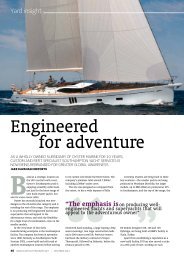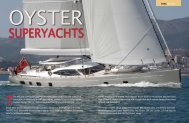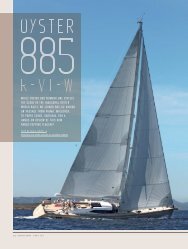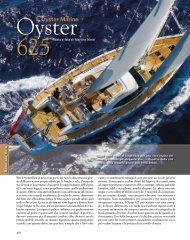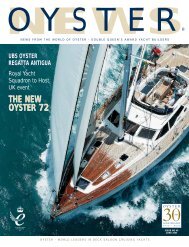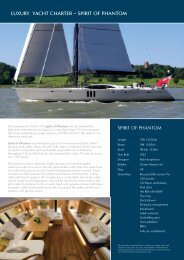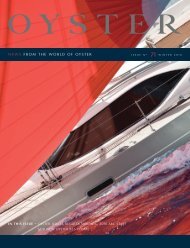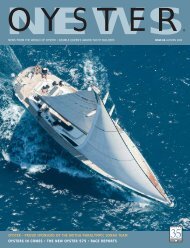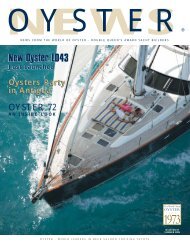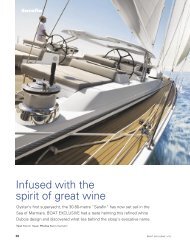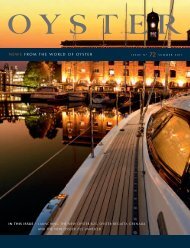Create successful ePaper yourself
Turn your PDF publications into a flip-book with our unique Google optimized e-Paper software.
He grew up cruising with his father on the<br />
Norfolk Broads, a unique system of shallow<br />
"ponds" formed by the River Bure 20 miles<br />
inland of Great Yarmouth, on England’s east<br />
coast. This is marshy, flat land requiring<br />
patience and cunning of sailors who race<br />
graceful, over-rigged sloops in the light, shifty<br />
winds that prevail. "My father had a 7-ton<br />
cabin cruiser," Amherst recalls. "It was rotten,<br />
having been too long in the barn. But it was<br />
an instant hit with a young boy. I could sit on<br />
the bunk and dangle my feet in the water that<br />
seeped in. I thought it was great. My father<br />
learned the mariners’ trick of sleeping with<br />
one hand over the side of his bunk so he’d<br />
know when to pump."<br />
His father, also a Squadron member, built a<br />
Contessa 32 at Camper Nicholson. Hugh<br />
raced and cruised on the boat with his father<br />
and brother from age 18. The Contessa was<br />
a particularly popular class, with as many as<br />
50 boats showing up for Cowes Week. After<br />
their marriage, Hugh and his wife, Lis, raced<br />
an IOD, and then a Daring, a 5.5 knock-off<br />
built of fibreglass that well-known British<br />
sailor Owen Aisher promoted as an Olympic<br />
trainer. It was a hot class, and Amherst was<br />
in the thick of it.<br />
Racing around the buoys was fun, but it was<br />
impossible for Hugh Amherst to resist the<br />
lure of the open ocean. The four Fastnet<br />
Races he participated in were more to his<br />
liking. In the 1980s, he took leave from E.A.<br />
Gibson to make Atlantic crossings under<br />
sail. He’s done four all told, twice each way,<br />
three as skipper. When asked about the<br />
passages, Amherst indicates the more recent<br />
ones he made in his <strong>Oyster</strong> Lightwave 48,<br />
purchased in 1988, were the best kind of<br />
crossings, "Completely uneventful, pleasant<br />
sails, as indeed one would expect from an<br />
<strong>Oyster</strong>." When pressed, he admits in his<br />
understated way that the first crossing he<br />
undertook a few months prior to the delivery<br />
of his <strong>Oyster</strong> was a bit of an adventure.<br />
When asked specifically about an article he<br />
wrote about that trip for Contessa magazine,<br />
he reluctantly handed it over.<br />
The Contessa editor’s note reports (with<br />
tongue in cheek) that Amherst "pawned<br />
house, wife, and dog to buy a Moody 47 that<br />
he planned to sell on his arrival in Antigua.<br />
Amherst named the boat, Solent Venture.<br />
The crossing began with a leg south from<br />
Falmouth across the Bay of Biscay to Lisbon,<br />
which turned out to be fraught with gales and<br />
a close encounter with the great October<br />
hurricane of 1987. By their third day out,<br />
according to crew Carole Bigland’s report<br />
(also in Contessa), "It was blowing a steady<br />
force 9, showing 45 knots on the clock...by<br />
evening the waves were 30 feet high...by<br />
midnight the wind was screaming through the<br />
rigging and the wind speed was off the<br />
clock...at 0100 hours Hugh took the decision<br />
to run before the storm back to Ushant." It<br />
was a smart move. Venture went on to Brest,<br />
where Optimist dinghies were being flung<br />
around like potato chips when the gale hit.<br />
Solent Venture’s crew feared the cleats might<br />
pop off the deck.<br />
Solent Venture’s passage to Antigua began<br />
with moderate breeze and toasts for "our<br />
cousin (an Admiral), the Navy, its traditions,<br />
and the weather for respecting its traditions,"<br />
Amherst writes. A bit later, during some nasty<br />
going, Amherst made a discovery any skipper<br />
would value: "If we played Handel’s Hallelujah<br />
Chorus out of the cockpit speakers, Michael<br />
(crewman Michael Ball) would drive singing<br />
and shouting with delight, impervious to cold,<br />
fatigue, pelting rain, or the seas now frequently<br />
breaking over the stern."<br />
Mainly the trip was plagued by light wind or<br />
none at all. After 11 days they were still 1,100<br />
miles from Antigua. Because of a failed<br />
warning light, they had inadvertently used up<br />
all 120 gallons of water on board. Then the<br />
engine refused to start. Then the bad news:<br />
no more cigarettes in the locker. But there<br />
was hope. "Down to starboard lay the<br />
blackest and most evil cloud imaginable<br />
‘ It’s a very competitive<br />
business, Peter Seal<br />
says. You need a killer<br />
instinct, because at the<br />
end of the day you do<br />
have to win.<br />
’<br />
OWNER PROFILE<br />
www.oystermarine.com<br />
33




